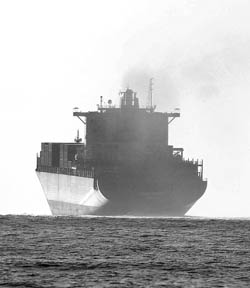How Big Boats Hurt and Intentional Fires Help Our Air
Santa Barbara's Air Pollution Czar Takes on Uncontrolled Tanker Pollution and Controlled Burns

The new state rule requiring that ocean going tankers plying California waters burn cleaner fuel will have only a marginal benefit on Santa Barbara’s air quality, according to Terry Dressler, executive director of the county’s Air Pollution Control District (APCD). Dressler noted that the new rules – just approved by the California Air Resources Board – will most dramatically reduce airborne particulates and oxides of sulfur, neither of which are big problems afflicting Santa Barbara’s onshore air quality.
That dubious distinction belongs to NOx – or nitrogen oxide, a smog precursor – and the new fuel rules will do little to effectively address that issue. Even so, Dressler estimated the new rules could reduce countywide NOx emissions by as much as six percent.
That’s not to say that the 7,000 tankers that travel through the Santa Barbara Channel a year are of no concern to Dressler and the APCD. They contribute about 14,000 tons a year to the county’s inventory of NOx. That’s 45 percent of the county’s total.
To address these emissions, Dressler said, “We want the Environmental Protection Agency (EPA) to impose new regulations limiting the emissions of NOx from those ships.” He described the progress made thus far by the federal agency as “dithering,” and explained, “That’s why we sued them in January.”
Specifically, the County of Santa Barbara is demanding that the feds require cleaner burning engines on new tankers and the installation of “scrubbers’ on existing tankers to keep as much of the emissions as possible from becoming airborne. This technology is far from cheap: It costs “hundreds of thousands of dollars per ship,” said Dressler. But, he explained, that translates to less than $10,000 per ton of pollutants captured or eliminated.
The EPA has been reluctant to jump into such murky regulatory waters, arguing the issue is really one of international trade, and one best negotiated by members of the International Maritime Organization. This reluctance has caused the EPA to run afoul of its own regulatory deadlines regarding tanker standards. The federal agency was required to issue new standards by April 2007, but when it failed to meet that deadline, it gave itself an extension. Part of the county’s lawsuit against the EPA challenges the federal agency’s right to give itself new deadlines. More substantively, Dressler said without the new regulations, members of the International Maritime Organization have had little incentive to take such negotiations seriously.
Dressler said even if the new scrubbers removed half of the airborne pollutants generated by tanker traffic, the air quality improvement would be substantial. The Santa Barbara APCD is currently working in partnership with several other air quality agencies, a shipping line, and a German manufacturer to produce a scrubber that’s cost effective and functional. Dressler said it’s still too soon to determine how well those efforts are going.
Dressler added that he had heard information to suggest that there are scientific voices within the EPA calling out for such regulations, but they’re being stifled by political appointees loyal either to the Bush Administration, the shipping industry, or both. Likewise, Dressler said the Bush White House is not noticeably worse than the Bill Clinton White House when it comes to tanker pollution. “Clinton wasn’t too good either,” he said.
Instead, he said, the real culprit has been the rise of global trade. “They can ship all these goods from China that we can buy for so little,” he said. “But if you added the cost of taking care of the pollution, maybe they wouldn’t be quite so cheap.”
Controlled Burns Make for Better Air
On a completely different matter, Dressler took exception with the conventional wisdom holding that air pollution control agencies such as his are responsible for the elimination of controlled burns as a method of reducing the risk of backcountry wildfires throughout Santa Barbara’s backcountry. “That’s not true,” he said. “We encourage controlled burns.”
Dressler said the smaller controlled fires generate far less air pollution than the larger conflagrations. He said that such burns must be planned to ensure that the winds blow the smoke away from populated areas, that the fires are small enough to be containable, and that there are well-defined lines of cut brush in place before such fires are started. Controlled burns have been used in years past to thin the backcountry fuel load so that, when fires start, they’re not so dangerous. In many popular accounts, this firefighting strategy has fallen prey to air pollution control agencies more concerned about smoke than fire.
Dressler stated the real demise of controlled burning as a firefighting strategy was caused by lack of funds. “It’s very expensive to put all the people in the field to make sure the fires don’t get out of control,” he said. “The federal budget for such efforts has been declining year after year after year.”
Those sentiments were echoed by Bill Giorgi, a well-known figure in Santa Barbara agricultural circles and a member of the county’s Fish and Game Commission since 1980. Giorgi contends that controlled burning promotes biological diversity in the backcountry and invigorates the backcountry streams and creeks. “It also happens to save a whole lot of money when it comes to the cost of fighting these forest fires,” he said.
Giorgi noted that in 1996, the Forest Service proposed spending $2 million a year over a 10-year period to burn out about 20,000 acres a year in controlled burns. “It was a great plan,” he said. “It would have improved habitat, saved money, and saved structures.” So what happened? “Personnel cuts. Budget cuts.”
Giorgi is now seeking to enlist the County Board of Supervisors in an effort to restore funding for the Forest Service to pay for controlled burns. He is tentatively scheduled to take his case to the board on September 2.



